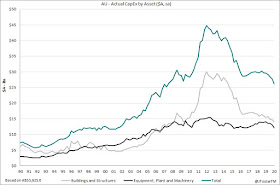Balance of Payments - Government Finance — Q2 | By the numbers
- Australia's current account remained in surplus for a 5th consecutive quarter widening to $17.7bn in Q2 in a stronger-than-expected outcome ($13.0bn). The surplus reported in Q1 was revised up to $9.0bn from $8.4bn.
- The surplus on the trade balance lifted to a new record high of $23.9bn from $19.1bn (revised from $19.2bn).
- The income deficit narrowed sharply to $5.6bn from $9.9bn (revised down from $10.6bn)
- Net exports are expected to add 1.0ppt to GDP growth in Q2.
- The separately released Government Finance data from the ABS reported that public demand was expected to add 0.6ppt to Q2 GDP growth, led by a 2.9% lift in consumption expenditure.
Balance of Payments - Government Finance — Q2 | The details
The past year has come very much against the run of play in the nation's history with the current account remaining in surplus over this period, something not seen since the early 1970s. Australia has tended to run deficits on its current account, with demand for domestic investment opportunities typically exceeding the pool of savings from which to fund them, thus requiring capital to be imported from offshore sources. However, the ramp-up in resources production following the investment upswing in the sector in the early 2010s (followed by the subsequent unwind) and favourable price movements has shifted the dynamic. This was then exacerbated in the June quarter by the volatility in trade flows that were enormously disrupted by pandemic restrictions. As a result, the trade balance has widened to $23.9bn, with the import side (-14.1%q/q) being more severely affected than the export side (-7.8%q/q). Adjusting for price movements, the volume of imports contracted by 12.9% in the June quarter, while export volumes fell by a smaller 6.7%. For GDP purposes, this will lead to a positive contribution of 1.0ppt in Q2.
The past year has come very much against the run of play in the nation's history with the current account remaining in surplus over this period, something not seen since the early 1970s. Australia has tended to run deficits on its current account, with demand for domestic investment opportunities typically exceeding the pool of savings from which to fund them, thus requiring capital to be imported from offshore sources. However, the ramp-up in resources production following the investment upswing in the sector in the early 2010s (followed by the subsequent unwind) and favourable price movements has shifted the dynamic. This was then exacerbated in the June quarter by the volatility in trade flows that were enormously disrupted by pandemic restrictions. As a result, the trade balance has widened to $23.9bn, with the import side (-14.1%q/q) being more severely affected than the export side (-7.8%q/q). Adjusting for price movements, the volume of imports contracted by 12.9% in the June quarter, while export volumes fell by a smaller 6.7%. For GDP purposes, this will lead to a positive contribution of 1.0ppt in Q2.
The story around the pandemic restrictions centres very much on the services sector, with the border closures and travel bans greatly restricting movement in and out of Australia. The import of services collapsed by 50.5% in Q2 (compared to a 2.4% fall from goods imports), largely reflecting the ban on overseas travel, which came to a near-complete stop in Q2 (-98.7%). Services exports fell by 18.4% in Q2 (goods exports were down by 3.5%) reflecting the ongoing loss of inbound travel (-24.4%q/q), though this remains supported to some extent by foreign students that have stayed on in Australia through the pandemic.
Meanwhile, the sharp narrowing of the income deficit reflected the impact of volatilty in the financial markets leading to lower returns for offshore investors.
In the latest Government Finance data for the June quarter, the ABS reported that government expenditure lifted by 2.9% to $99.7bn, while underlying investment (adjusted for private/public transfers) declined 1.8% to $23.5bn. Overall, the ABS advised public demand was expected to add 0.6ppt to Q2 GDP growth.
Balance of Payments - Government Finance — Q2 | Insights
The Australian economy likely contracted in the order of 6% in the June quarter reflecting the full scale of the disruption of containment measures on activity, albeit with considerable uncertainty remaining around the consumption of household services.







































